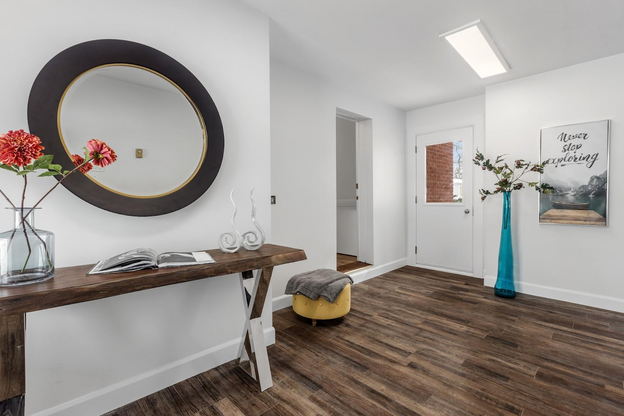
If you are a landlord, creating practical, functional, attractive, and affordable spaces for your tenants is a delicate balancing act. Going too far one way or another can drive particular tenants away and leave you with properties that appeal to nobody.
When choosing material for the floor in your rental properties, LVT flooring can be a fantastic option.
Let’s discuss in more detail why LVT is the perfect choice for landlords.
What is LVT Flooring?
LVT flooring stands for Luxury Vinyl Tile flooring, a type of resilient flooring designed to mimic the look and feel of natural materials such as hardwood, stone or ceramic tiles while offering several practical benefits such as durability, water resistance, easy maintenance and affordability.
LVT flooring typically consists of several layers, including a backing layer, a printed design layer, a wear layer, and a protective topcoat layer. The printed design layer can replicate the appearance of different types of flooring, such as wood, stone or tile, and can be customised to create a wide range of colours, patterns, and textures.
LVT flooring is commonly used in residential and commercial settings, and it can be installed using different methods such as glue-down, click-lock or loose-lay. It is a popular flooring option because of its versatility, durability, and low maintenance requirements.
LVT Looks Fantastic
As we mentioned earlier, LVT is used to replicate the look of other types of material. For example, it can mimic the visual appearance of wooden flooring. Wooden floors, while beautiful and majestic, can be expensive, which means they are unsuitable for rental properties.
LVT features an embossed top layer, creating an incredible sense of depth and realism akin to the deep tones and patterns you might see in genuine wooden flooring.
LVT is Extremely Durable
When renting out a property, you often don’t fully know who your tenants are. They could be perfectly responsible young professionals, or they could be students who like to party. Either way, it is your job as a landlord to ensure the floor is durable and able to withstand whatever might come it’s the way. This is as much for the safety of your tenants as it is for your financial health.
The particular way in which LVT is constructed means that it is extremely tough and durable. Despite the thinness of the tiles, they can withstand impacts without cracking or shattering. Moreover, they’re highly waterproof and resistant to scratches and dents.
LVT flooring is known for its durability. It is designed to be long-lasting and withstand heavy foot traffic, making it a popular flooring option for residential and commercial settings. LVT flooring has a wear layer designed to protect the design layer, making it resistant to scratches, scuffs, and stains. Also, LVT flooring is water-resistant, making it suitable for areas prone to moisture or spills. With proper installation and maintenance, LVT flooring can last for many years, making it a cost-effective option in the long run.
LVT is Easy to Clean
If you rent out your properties on short-term leases, you will no doubt be familiar with cleaning out a property to prepare it for the arrival of new tenants. Depending on the state the previous tenants have left the property; this can be an easy job or a complete nightmare.
Thankfully, LVT is extremely easy to clean. It doesn’t stain or mark easily, and spillages can be quickly and easily mopped up. It needs a quick once-over with a damp cloth to return to its sparkling best. This means you can get your properties ready for the arrival of new tenants in the blink of an eye.
LVT is Easy to Install
As a landlord, cutting costs and making savings wherever possible is undoubtedly one of your top priorities. Especially in today’s economic climate, you must reduce your overheads, but equally important, this comes at something other than the expense of the service you provide.
When getting new flooring, often the installation is the priciest part. With a little bit of planning and preparation, you can install LVT yourself. This can see you make big savings, which can then be redistributed to other business areas.
To install LVT yourself, first, you must prep the area and ensure it’s flat and clear of debris. The tiles must be acclimatised to the room by leaving them for at least 48 hours. Then, install an LVT underlay material; this should lie at a 90-degree angle to the direction of the flooring. Finally, place the LVT tiles on top of the underlay. Start against a wall and ensure the gaps between the tiles are even and consistent.
Conclusion
LVT is the ideal choice of flooring material for rental properties. It’s attractive, durable, and easy to clean. What’s more, LVT can even be installed yourself to save money.




 POSTED BY
POSTED BY 

